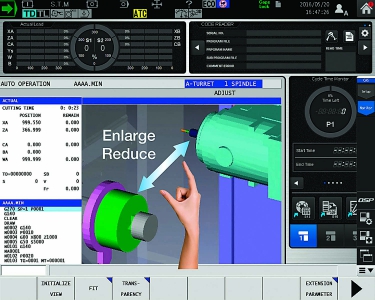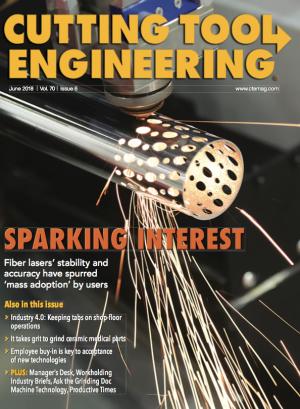Advanced machine tool controls infused with artificial intelligence (AI) can learn about your machining processes. With this knowledge, a CNC can automatically take action that boosts machining speed and accuracy, as well as slash unplanned downtime for maintenance.
Learning takes several forms with CNCs made by FANUC America Corp., Hoffman Estates, Ill. Among the available learning options is a feature called high-precision learning control.
Daniel Knepp, senior CNC applications engineer at FANUC, explained how the feature would work in a grinding process used to produce crankshafts. To grind the crankpins, the machine would be set to “pin-chasing” mode, wherein the grinding wheel follows the rotating part to stay in contact with the surface of the eccentric pins. As the wheel rapidly moves back and forth to chase a pin, machining error occurs with every revolution of the part.
A FANUC CNC with learning control, however, would compensate for error by adjusting the machine’s motors for the next revolution. After a number of revolutions, the applied compensation can reduce machining error by 90 percent or more, Knepp said.
If the error were 10µm, for example, the application of learning could reduce it to 1µm or, perhaps, even to a submicron level if conditions were ideal, he said.

Featuring deep learning-infused AI, Okuma’s OSP-P300A can be used to predict when machine tools will experience problems if preventive maintenance isn’t done beforehand. Image courtesy of Okuma America.
Machines without learning control would have to be run slower to achieve the required part accuracy. With the feature, manufacturers could speed up their processes—if their tools allowed it—and still get the desired accuracy, Knepp said.
Of course, there’s a price to pay for these benefits. Learning control and FANUC’s other learning features add costs to a control because they require additional memory and software, Knepp noted.
Another learning-capable control product is available from Okuma America Corp., Charlotte, N.C. Okuma has introduced what it calls deep learning-infused AI for CNC machining. This AI capability, which resides in the control processing unit of the company’s OSP-P300A CNC, allows the control to run diagnostics without human intervention. The idea is for the CNC to spot potential problems before they become major issues that could cause some type of failure in a machine tool.
To be capable of deep learning-infused AI, a CPU needs enough capacity to store data gathered during machining processes that take place throughout the life of a machine. “You need a ton of data for AI to really work,” said Brad Klippstein, Okuma’s supervisor of product specialists. “And the more information you push to it, the better the system works.”
To learn about the processes a machine runs, the CPU also needs a great deal of processing power to analyze the data gathered. This power helps the control predict events that could cause a failure if preventive maintenance isn’t done beforehand.
“Normally, guys fix things as they happen,” Klippstein said. The new Okuma control “is able to predict when a failure could happen.”
Notified that a particular component in a machine could fail in the near future, machining personnel can schedule a convenient time to take the machine out of operation so that necessary repairs can be made. They can also acquire the replacement component in advance of the planned downtime.
The alternative can be ugly. The machine could suddenly shut down in the middle of a big job. In addition, time can be lost figuring out what the problem is and then obtaining any part or parts needed to fix the machine. When it comes to dealing with machine problems, “getting notification in advance is huge,” Klippstein said.
So far, no one is using the OSP-P300A for machine self-diagnostics and predictive maintenance. But, according to Klippstein, Okuma plans to show what the control can do with some of its machines at the International Manufacturing Technology Show in September.
“We are using that as our opening to share these details with the public,” he said.
It will give IMTS visitors a chance to learn what machine learning can do.
Contact Details
Contact Details
Related Glossary Terms
- computer numerical control ( CNC)
computer numerical control ( CNC)
Microprocessor-based controller dedicated to a machine tool that permits the creation or modification of parts. Programmed numerical control activates the machine’s servos and spindle drives and controls the various machining operations. See DNC, direct numerical control; NC, numerical control.
- grinding
grinding
Machining operation in which material is removed from the workpiece by a powered abrasive wheel, stone, belt, paste, sheet, compound, slurry, etc. Takes various forms: surface grinding (creates flat and/or squared surfaces); cylindrical grinding (for external cylindrical and tapered shapes, fillets, undercuts, etc.); centerless grinding; chamfering; thread and form grinding; tool and cutter grinding; offhand grinding; lapping and polishing (grinding with extremely fine grits to create ultrasmooth surfaces); honing; and disc grinding.
- grinding wheel
grinding wheel
Wheel formed from abrasive material mixed in a suitable matrix. Takes a variety of shapes but falls into two basic categories: one that cuts on its periphery, as in reciprocating grinding, and one that cuts on its side or face, as in tool and cutter grinding.



